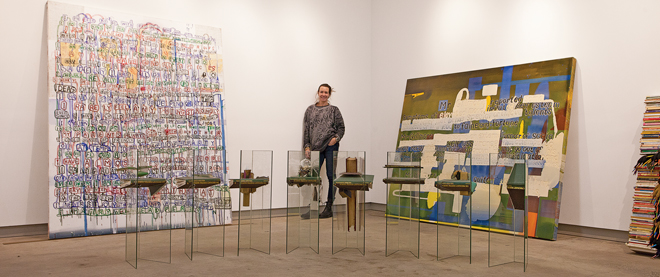Private art in the public eye
Scrap Metal joins a small clutch of art venues where cash is not strapped
Photograph by Liz Sullivan
Share

Toronto art collectors Samara Walbohm and Joe Shlesinger have only one criterion for buying a piece of art—it must be something they love. But their love is broad and imaginative enough to encompass artists as diverse as blue-chip boldfaces General Idea and Ed Burtynsky to lesser-known names such as Vancouver’s Graham Gillmore. It’s a love so overwhelming that the couple, faced with a collection that had outgrown their three homes—and that swelled every time they jetted off to another international art fair—set out earlier this year to find a new place to store it. But when they did finally find that place, they decided to turn it into a private gallery and share their love with the world.
That gallery, Scrap Metal, opens in Toronto this week, and its first show, “Read All Over,” consists of more than 20 paintings, sculpture and video all exploring the role of text and books in contemporary visual art. Books are in Walbohm’s blood; she’s also co-owner of Type Books, an independent bookshop. Shlesinger himself is a photographer and the managing director of Callisto Capital, a private market equity firm. Ninety-five per cent of the work in the show comes from the wealthy couple’s collection, and includes pieces by Douglas Coupland, Micah Lexier and Annette Messager, as well as an installation by the late British conceptual artist John Latham that has never been seen in its entirety in Canada. Before the 5,200-sq.-foot, L-shaped space had been transformed into a gallery, it had been vacant for years; prior to that, it was a Portuguese winemaking facility. The name came from an old sign found on the premises.
There’s only a small clutch of private exhibition spaces in Canada, but they have often been the most adventurous and nimble contemporary art venues in the country. Private galleries—which tend not to charge admission—enjoy a freedom from both the financial pressures of commercial galleries and the sluggishness that can plague fund-starved public institutions. “We don’t have a massive bureaucracy and a million stakeholders,” says John Zeppetelli, the curator at DHC/ART, a much heralded, four-year-old foundation in Montreal created by theatre and film producer Phoebe Greenberg. “We do what we want, but we do it responsibly.” Walbohm echoes this sentiment: “Something that’s been bugging us for a few years is this emphasis on brands and big names. The Art Gallery of Ontario, for example, has to put on a blockbuster show to get people in the door. But we don’t have to do that.” In 2009, condo developer and marketer Bob Rennie, who has publicly feuded with the Vancouver Art Gallery, spent close to $20 million converting the oldest building in Vancouver’s Chinatown to house his own personal collection of more than 1,000 international works. The acclaimed Palestinian artist Mona Hatoum, whom Rennie collects, has called it “a dream for any artist.”
The best-known private collector and curator in the country is Ydessa Hendeles, whose eponymous foundation and its astonishing, experimental exhibitions—what she calls “curatorial compositions”—first introduced Canadians to the work of Shirin Neshat, Louise Bourgeois and many others. “It’s a wonderful injection of life in the city,” she says of Scrap Metal. “The ecology of the art world needs all of it—good critics, great artists, discriminating collectors.”
Walbohm looks to Hendeles as a curatorial lighthouse, but, unlike the older collector, she won’t be a sole directorial voice. And unlike Rennie, the space won’t just exhibit works from her own collection. “We want it to be community-driven and collaborative,” says Walbohm, who hopes to collaborate with institutes beyond the city’s borders—the Banff Centre, say, or London’s White Cube.
It’s tempting to view private galleries as vanity projects, extravagant paeans to a rich person’s ego. But Walbohm says many great artists don’t get the recognition they deserve because their art is locked away in private homes where few get to enjoy it. Says Walbohm, “We love the idea of presenting underappreciated Canadian artists along with international masters.”